NOS
X CUPRESSOCYPARIS
PAGE |
Copyright 1998-2004. New Ornamentals
Society. All Rights Reserved.
Lawful for
online access only by current society members.
All downloading, printing, saving to media, imaging,
screen capture, or offline use is prohibited.
Duplication by any means, method, or technology is
unlawful.
Do not link to this page. |
x Cupressocyparis
leylandii 'Atlas' - online source requested
x Cupressocyparis
leylandii 'Blue Jeans'
ns: a
listed name.
x Cupressocyparis
leylandii 'Castlewellan' ('Castlewellan Gold')
ht: 26 ft. in 16 years (original tree)
ha: conical to broadly ovoid
lc: bright golden yellow new growth becoming yellow-green and
lime by the end of the season.
lc: It is rather green and not so bold in warmer climates.
lt: more divergent (semi-adult) type foliage than many other
clones
or: Castlewellan Ireland from C. macrocarpa 'Lutea' x
Chamaecyparis nootkatensis
in: European trade c. 1970
so: Forest Farm
x Cupressocyparis
leylandii 'Clun Rectory' ('Clun')
ha: open and 'slender'
lc: dark grey green 'with some blue'
fot: plumose type
ns: Welch in The Conifer Manual says 'Clun Rectory' was based on
a
ns: misunderstanding. Was it not a rectory? We have asked Mr.
ns: Welch to confirm his rejection of the earlier full name.
or: about 1900 at Clun Rectory in Shropshire UK and noticed by
Mitchell
li: Mitchell, A. 1985. Clones of Leyland cypress. Int. Dendr.
Soc. Year.
li: 1985: 97-100.
x
Cupressocyparis leylandii 'Contorta' = 'Picturesque'
x Cupressocyparis leylandii 'Drabb' (1/01)
x Cupressocyparis
leylandii EMERALD ISLE™ ('Moncal')
ht: 20-25 ft. tall x 6-8 ft. wide
ha: denser than 'Haggerstown Grey', having many flat sprays of
foliage
lc: bright green
dr: said to be canker resistant
so: UK
in: Monrovia Nur. CA USA 1992 to US trade
x Cupressocyparis
leylandii 'Ferngold' (2/00)
x Cupressocyparis
leylandii 'Galway Gold' = 'Castlewellan'
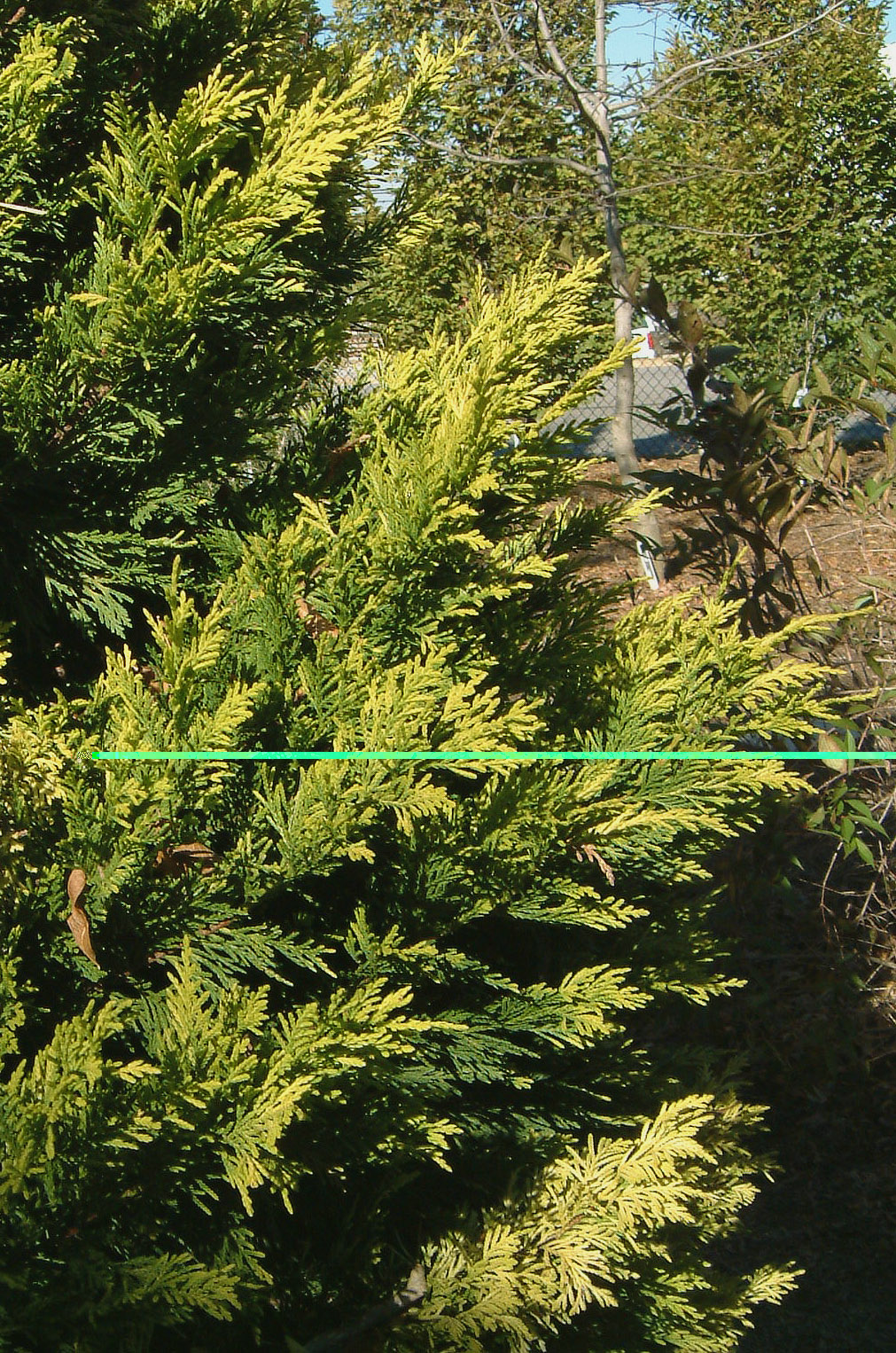 'Golconda' ('Colconda')
- click image
'Golconda' ('Colconda')
- click image
'Golconda' is a lovely rich
yellow gold if given enough sun. Inner shoots are dark
and contrast well. The sprays are thick, strong and bold. It
is not so impressive as most Chamaecyparis lawsoniana
clones but in areas where heat prevents their use and
Cupressus sempervirens is slightly tender, this is a nice
choice.
x Cupressocyparis leylandii 'Golconda' ('Colconda')
ha:
compact, pyramidal
lc: bright lemon yellow - best shade and distribution of gold
known to date.
or: sport of 'Haggerston Grey' around 1977 by Mr. Wyant of
Bedfordshire UK
in: first plants known in US collections around 1987 or 1988
rd: 197 by D.F. Wyant
rai: should replace 'Castlewellan' which is often yellow green or
at
rai: best gold-tipped by summer. This is gold like Cupressus
cultivars.
evMitchell: 'soon be seized by the trade as an evident
money-spinner'.
li: Mitchell, A. 1985. Clones of Leyland cypress. Int. Dendr.
Soc. Year.
li: 1985: 97-100.
in: known in US collections since about 1986.
x
Cupressocyparis leylandii 'Gold Cup'
lc: bright yellow new growth, said to hold color in NZ winters
x
Cupressocyparis leylandii 'Gold Dust' = 'Silver Dust'
x Cupressocyparis
leylandii GOLD MEDAL ('Peter Nitschke')
ha: erect,
dense, soft to touch. First order branchlets have short
internodes. Less conical than
ha: 'Castlewellan'. Has more a planar or flat plane look than
'Castlewellan'
lc: yellow becoming yellow-green
ns: GOLD MEDAL is apparently a trademark name since 'Peter
Nitschke' is published as the cultivar
ns: name.
or: selected from population of 'Castlewellan'
li: Koelewyn, J. and Nitschke, P. 1992. Plant Varieties Journal
5(2): 10-11
x Cupressocyparis
leylandii 'Gold Nugget'
ha: compact, pyramidal
lc: golden yellow
eval: Dirr states that 'Gold Rider' is superior
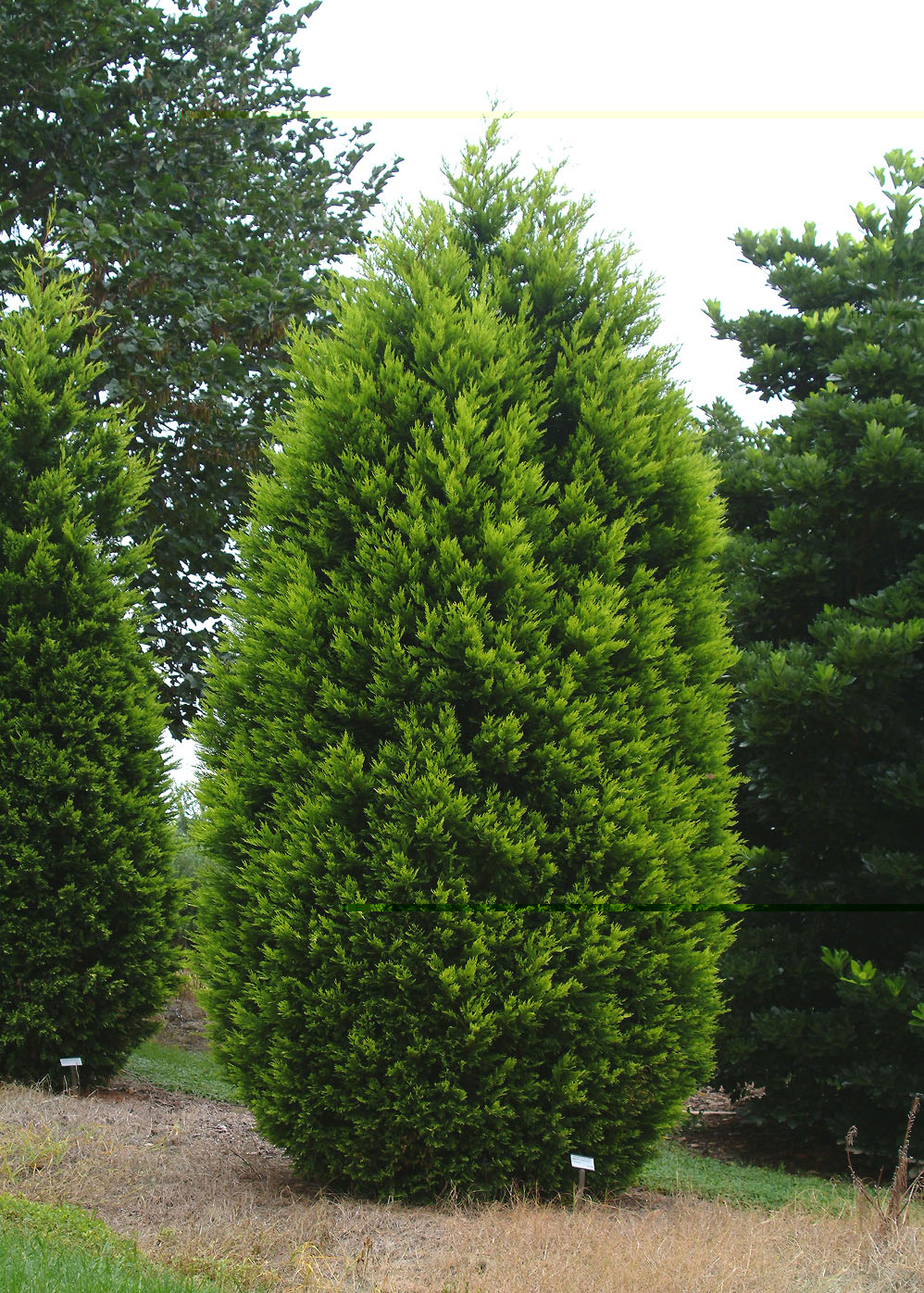 'Gold Rider'
- click image
'Gold Rider'
- click image
Hampton Roads Arboretum, VA USA. Summer 2003. These bright, glowing and feathery
plants immediately appealed to us. One can instantly see
how the much greener and less finely feathered gold clones of the past quickly
pale in comparison. It is certainly the most proven gold clone in
southeastern US trials (2004) though we have yet to grow everything known in
Europe in rigorous, side-by-side trials.
x Cupressocyparis
leylandii 'Gold Rider'
ha: columnar with shoots in flat planes unlike 'Castlewellan'.
Can grow 2 feet at year.
ha: it is far more feathery and interesting than 'Castlewellan'.
lc: bright yellow, darkening into gold.
or: sport of 'Leighton Green' found in Holland
in: Dutch trade c. 1986 by Vergeer of Boskoop
eval: experts from van Gelderen to Dirr consider the best of the
gold cultivars to date (2001)
so: Forest Farm
x Cupressocyparis
leylandii 'Golden Sun'
ha: semi-dwarf and bushy unlike most other gold clones
fot: plumose
lc: bright gold
or: sport of 'Haggerston Grey' at Barnham Nurseries in Sussex UK
about 1966
li: Mitchell, A. 1985. Clones of Leyland cypress. Int. Dendr.
Soc. Year.
li: 1985: 97-100.
x
Cupressocyparis leylandii 'Goldness'
lc: green with some shoots mottled yellow
rd: 1976 by S.G. McMinn
in: Ness Nur. of Londonderry N. Ireland
li: Welch, H.J. 1990. The conifer manual. Kluwer Press. p. 284.
x
Cupressocyparis leylandii 'Gold River'
ha: open and horizontal unlike most others which are narrower
lc: bright yellow
or: found in Boskoop Netherlands
li: Van der Laar. 1985. Dendroflora 22: 73.
x Cupressocyparis
leylandii 'Gold Way'
ns: a listed name with the Anthoine Arboretum 2000.
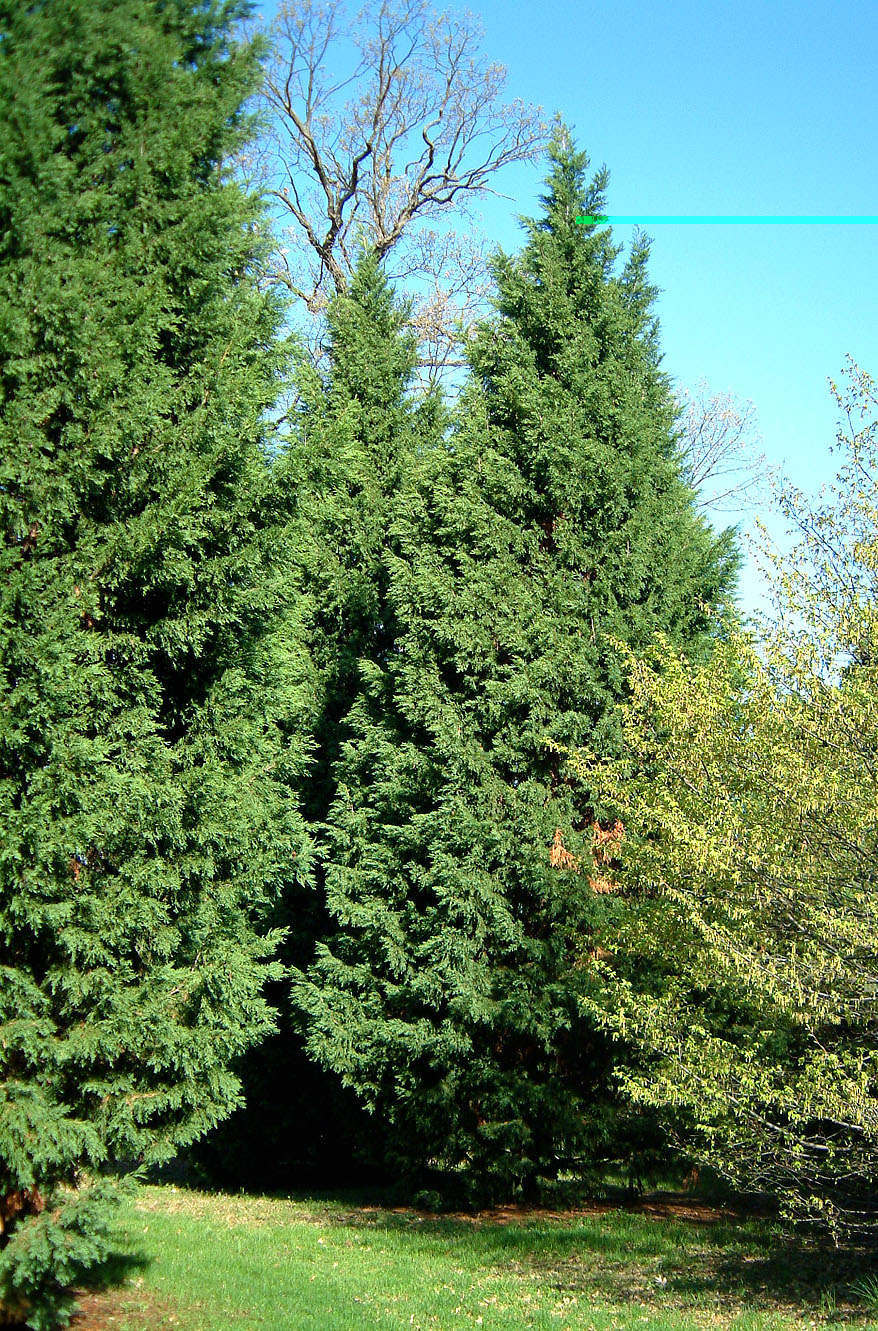 'Green Spire'
- click image
'Green Spire'
- click image
US National Arboretum. Summer 2002. One of the older examples of this cultivar
that is virtually unknown in US gardens. It has little to offer over 'Haggerston
Grey'
and the newer stuff.
x Cupressocyparis
leylandii 'Green Spire'
ha: narrowly columnar, very dense sometimes with branchlets at
irregular angles. Central leader
ha: may not develop strongly.
lc: bright green
or: Haggerstyon Castle UK and known as "Clone 1"
eval: in the US at least 'Leighton Green' has got much more
attention among green clones.
x Cupressocyparis
leylandii 'Grelive' (2/00) = 'Olive's Green'
x Cupressocyparis
leylandii 'Haggerston Grey' ('Haggerstown Grey')
ha: columnar to broadly ovoid with foliage is distinct flat
planes. Lateral branchlets can be
ha: very irregular and turned at an angle. Looser overall than
'Leighton Green'.
lc: grey-green to faintly blue-green - 'Leighton Green' is much
greener side by side.
eval: this is the most popular clone in the US and millions of
plants sold as the species
eval: are of this clone. It is unfortunately very prone to bag
worms if stressed by drought, too
eval: shade, and/or clay soils. Plants can easily defoliage
20-50% by late summer if not treated.
x Cupressocyparis
leylandii 'Harlequin'
ha: mutiple leaders or at least more so than 'Silver Dust'
lc: as 'Haggerston Grey' but mottled clear more ivory shade than
lc: 'Silver Dust' and more evenly distributed chimeral zones
fot: shoots more sparse than 'Silver Dust' which is often densely
formed
or: sport of 'Haggerston Grey' around 1975 by Lord Bradford in UK
eval: Dirr considers 'Silver Dust' to be the more appealing of
the two.
li: Mitchell, A. 1985. Clones of Leyland cypress. Int. Dendr.
Soc. Year.
li: 1985: 97-100.
x
Cupressocyparis leylandii HERCULEAŽ 'Miniver' (10/01)
ht:
1.5-2.0 m in just 5 years
ha: densely ovoid, highly vigorous
lc: blue-green, resembling C. lawsoniana according to photos we
have seen.
lu: suitable for large hedge or windbreak
or: believed to come from INRA in France (?)
x Cupressocyparis
leylandii 'Hillspire'
ha: narrowly pyramidal
lc: bright green
li: Iseli Nur. Catalog 1989
ns: Dirr says he has not seen and neither have anyone we know.
There is a juniper called
ns: 'Hillspire' but the Iseli folks are far too expert to make
that mistake. Dirr wonders if it
ns: might be 'Green Spire'. The 'Hillspire' name would suggest a
connection with D.Hill Nursery.
x Cupressocyparis
leylandii 'Hyde Hall'
ht: 2-4 ft. tall after many years. Plants to 6 ft tall are known.
ha: dwarf and conical to globose something like a smaller
Chamaecyparis lawsonaian 'Erecta'
lc: bright pale green
fot: 100% juvenile unlike all other clones
rai: considered inferior to juvenile Chamaecyparis and Thuja in
most cases
ch: subject to winter damage more easily
rd: by R.H.M. Robinson in 1976
eval: juvenile cultivars of Chamaecyparis thyoides are more
durable in most US areas.
li: Welch, H.J. 1990. The conifer manual. Kluwer Press. p. 286
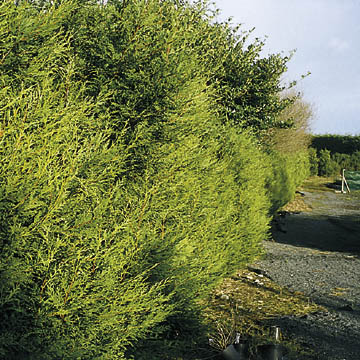 IRISH MINT™
- click image
IRISH MINT™
- click image
x
Cupressocyparis leylandii IRISH MINT™
lc: light
yellowish-green but not quite the mint green of other plants.
eval: Dirr says a "superior root system" is claimed
id: it resembles a less yellow version of 'Castlewellan' and has
similar leaf divergence.
in: Flowerwood Nursery before 1999.
so: source (Plants By Mail)
x Cupressocyparis
leylandii 'Jacobel' (1/01)
x Cupressocyparis
leylandii 'Jubilee'
lc: grey-green mottled in yellow but not as brightly as 'Silver
Dust' nor as appealing.
x Cupressocyparis
leylandii 'Leighton Green'
ha: columnar to narrowly pyramidal, usually with a single leader.
frq: cone production is not uncommon on rather old trees
lc: bright green - not nearly so greyish as 'Haggerston Grey'
or: UK c. 1911 as "Clone 11".
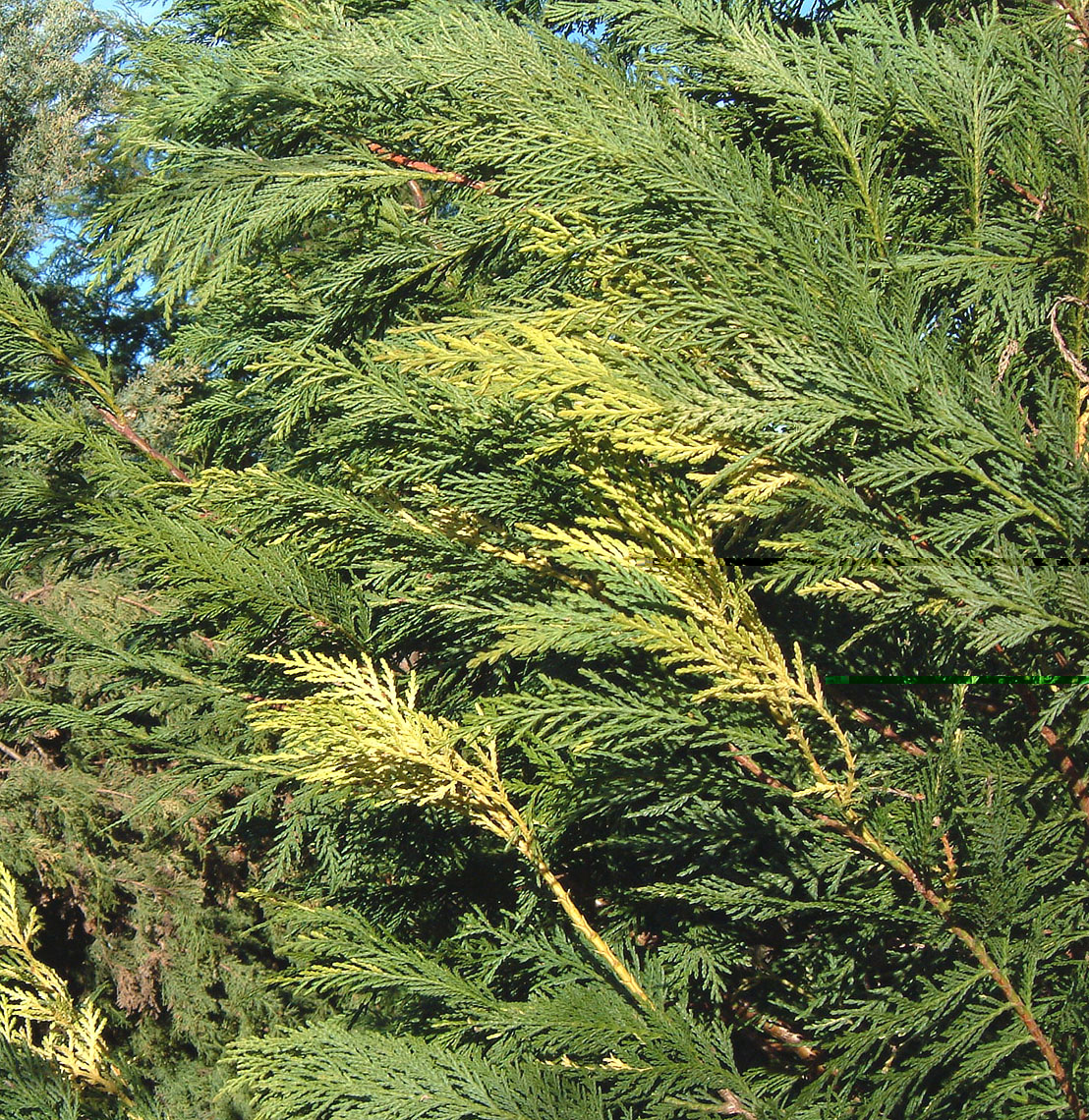 'McCracken's
Variegated' - click image
'McCracken's
Variegated' - click image
JC Raulston Arboretum. Summer 2003.
x Cupressocyparis
leylandii 'McCracken's Variegated' (12/02)
lc: irregularly mottled light yellow in sectors, many shoots all
green. See photo above.
or: Pat McCracken, Raleigh, NC. It appears to be a sport of
'Haggerstown Grey' or 'Leighton Green'
lsp: known from a speciman at the Raulston Arboretum about 10
feet tall in 2002
x Cupressocyparis
leylandii 'Medownia'
ns: a listed name in the RHS PLANT FINDER 1998.
x Cupressocyparis
leylandii 'Michellii'
ns: a listed name in the RHS PLANT FINDER 1998. Latin form is
almost certainly not valid.
 'Naylor's Blue'
- click image
'Naylor's Blue'
- click image
Hampton Roads Arboretum. Summer 2003. Virtually all the very old Leylands in the
US are 'Haggerston Grey' and so the sight of a nice, fat
and happy 'Naylor's Blue' is a rare event - usually one located in a
serious woody plant collection.
x Cupressocyparis
leylandii 'Naylor's Blue'
ha: columnar, considerably less formal and more open than
'Haggerston Grey'. It is less
ha: narrow than 'Haggerston Grey'. Unfortunately it is slower
than many clones so a good
ha: hedge or it takes more time to develop.
lc: distinctly blue-green to grey-blue, often best when planted
with a greener cultivar for
lc: some contrast. It is probably the best blue cultivar of this
species but given the
lc: lovely blue colors available in Chamaecyparis lawsoniana it is not
always used - unless
lc: that species is not adaptable (ie. Southeast US)
or: Clone 10 from the original 1911 selections in the UK
so: Forest Farm
x Cupressocyparis
leylandii 'New Ornament'
ha: irregular, contorted somewhat like 'Picturesque' ('Contorta')
but believed to be different
ns: the name is very unfortunate since the major pest bagworm
looks like hanging ornaments
ns: on this species.
or: Konijn, Netherlands
li: Dirr, M.A. 1998. Manual of Woody Land. Plts. Stipes. p. 306
x Cupressocyparis
leylandii 'Olive's Green' (1/00) - history, source (Carrigdale
Nursery)
x Cupressocyparis
leylandii 'Peter Nitschke' (2/00) SEE 'Gold Medal'
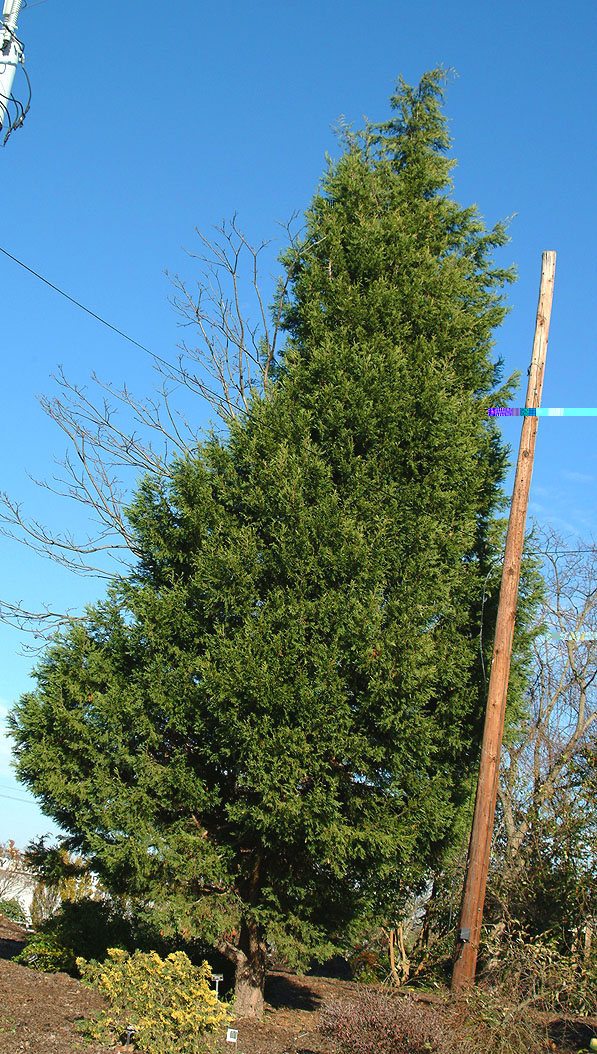 'Picturesque' ('Contorta')
- click image
'Picturesque' ('Contorta')
- click image
JC Raulston Arboretum. December 2003. This may be the oldest example in the
eastern US. It looks like nothing more than a more
irregular and umkempt 'Haggerston Grey' and thus without much merit for
landscaping.
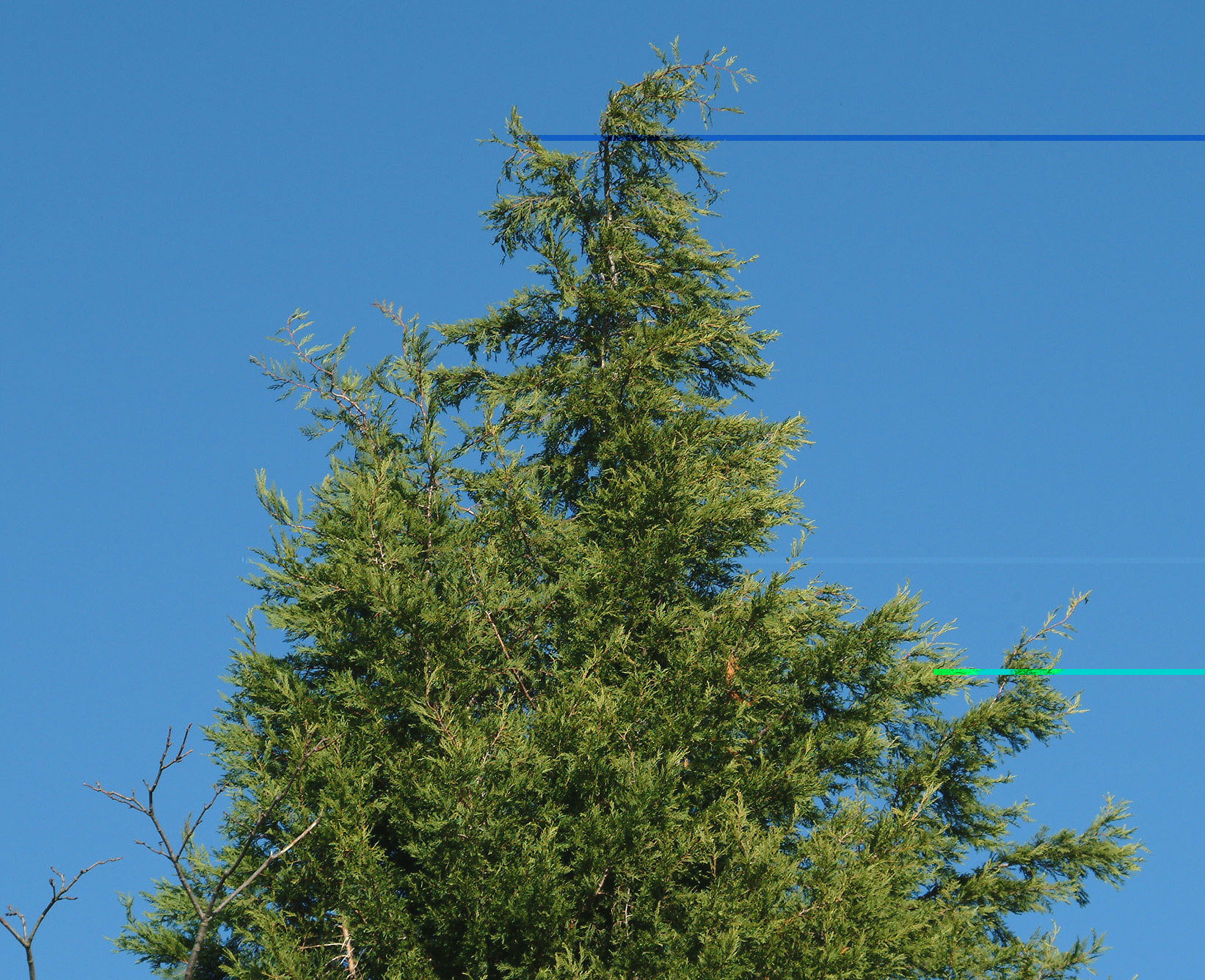 'Picturesque' ('Contorta')
- click image
'Picturesque' ('Contorta')
- click image
This is a zoom in on the tall tree above, showing better the contortions in the
canopy. Only the apex of old plants is very impressive. Young
plants in nurseries are often sharply twisted but they quickly more more regular
and less remarkable.
x Cupressocyparis
leylandii 'Picturesque' ('Contorta')
ha: broadly upright shrub with twisted new growth that later
straightens, overall a more irregular 'Haggerston Grey' sort. Occasional shoots
ha: will loop or get knotted with some owners helping things along to aid in the
curious appeal.
lc: bright green
ns: the plant has circulated under the name 'Contorta' which
doubtless
ns: arose many years after 1959, the year that marked the end to
Latin cultivar names.
eval: comparison with 'New Ornament' is worth a try.
or: Mitsch Nursery, OR USA c. 1980 per RHS checklist. Jacobsen (1996) puts it as
far back as 1972-3 and given his
or: careful research, we will favor this second report. Almost certainly a sport
of 'Haggerston Grey' which is closely resembles.
li: Porterhowse Farms 1998 Catalog: 15.
so: Forest Farm under 'Contorta'
x
Cupressocyparis leylandii 'Robinson's Gold'
ht: 25 ft. tall x 10 ft. wide in 20 years (original tree)
ha: conical to broadly columnar, dense, but vigorous reminding
one of a yellow 'Leighton Green'
lc: bright yellow to yellow-bronze becoming dark yellow
or: George Robinson, Belvoir Park, Belfast, N. Ireland as
seedling in 1962
x Cupressocyparis
leylandii 'Rostrevor'
ha: more vigorous than 'Leighton Green'
lc: green much like 'Leighton Green'
fot: laterals wider spaced than 'Leighton Green' which is
otherwise similar
fot: leaders more 'diamond shaped' than very similar 'Leighton
Green'
or: seedling at Rostrevor UK known since 1908 but probably back
to 1870?
in: planted in 1949 at Castlewellan where it became widely
noticed
hp: possibly a 'reverse cross' of the original cross
li: Mitchell, A. 1985. Clones of Leyland cypress. Int. Dendr.
Soc. Year.
li: 1985: 97-100.
x
Cupressocyparis leylandii 'Rua'
so: source
(Cedar Lodge Nursery)
x Cupressocyparis
leylandii 'Silver Dust'
ha: conical to broadly columnar, only a little slower than other
cultivars
lc: grey-green with generous mottling of white. On well-selected
stock it can be 30-45% of the
lc: surface but mature plants may show as 20% white. It is best
viewed up close (5-15') as it
lc: becomes something of a grey or silver haze beyond that range.
Good fertilization will make
lc: the base caller darker for added contrast but it may decrease
the amount of white too.
frc: cones are always full of white chimera!
prop: Dirr reports it rooting "faster and in higher
percentages" than other cultivars
or: US National Arboretum as sport of 'Leighton Green'. Dirr and
others suggest this origin does
or: need seem to fit and indeed the bluer base color is more like
'Haggerston Grey'. And since
or: it's ability to be rooted as quite opposite that of 'Leighton
Green' we have another clue that
or: it may not come from that clone unless quite a few things
mutated along with the foliage.
so: Forest Farm
Cupressocyparis
leylandii 'Sirebo' (2/02)
ns: a listed name.
x Cupressocyparis
leylandii 'Sparkler'
lc: new growth cream-colored becoming glaucous-green with faint
mottling.
ns: this clone has been withdrawn from production as it proved
unstable
ns: and more of a curiousity item than a true ornamental. It was
ns: initially thought to be a herbicide-induced variegation but
ns: five plants maintained the coloration (unsprayed) for a
period
ns: exceedling two years.
in: not introduced to the trade.
or: sport found by Laurence C. Hatch among an old planting of
'Haggerston Grey'
or: at the NC State Univ. Arboretum c. 1985
x
Cupressocyparis leylandii 'Spring Gold' ('Smith's Gold')
lc: yellow
or: sport of 'Haggerston Grey' at Pickering UK by Stephen Smith
about 1974
li: Mitchell, A. 1985. Clones of Leyland cypress. Int. Dendr.
Soc. Year.
li: 1985: 97-100.
x Cupressocyparis
leylandii 'Stapehill' ('Stapehill Hybrid', 'Stapehill 21')
ht: 50 ft. tall in 40 years
st: yellowish-green becoming orangeish-brown with maturity
lc: dark blue-green
lt: thicker foliage than some clones
or: Barthelemy Nursery, Stapehill, Dorset, England in 1940. There
is also a clone 20 that is
or: not regarded as worth introduction.
Cupressocyparis
leylandii 'Star Wars' (2/02)
lc: mottled yellow
x Cupressocyparis
leylandii 'Superl'
so: source
(Cedar Lodge Nursery)
x Cupressocyparis
leylandii 'Winter Sun'
in: Charles Ellis
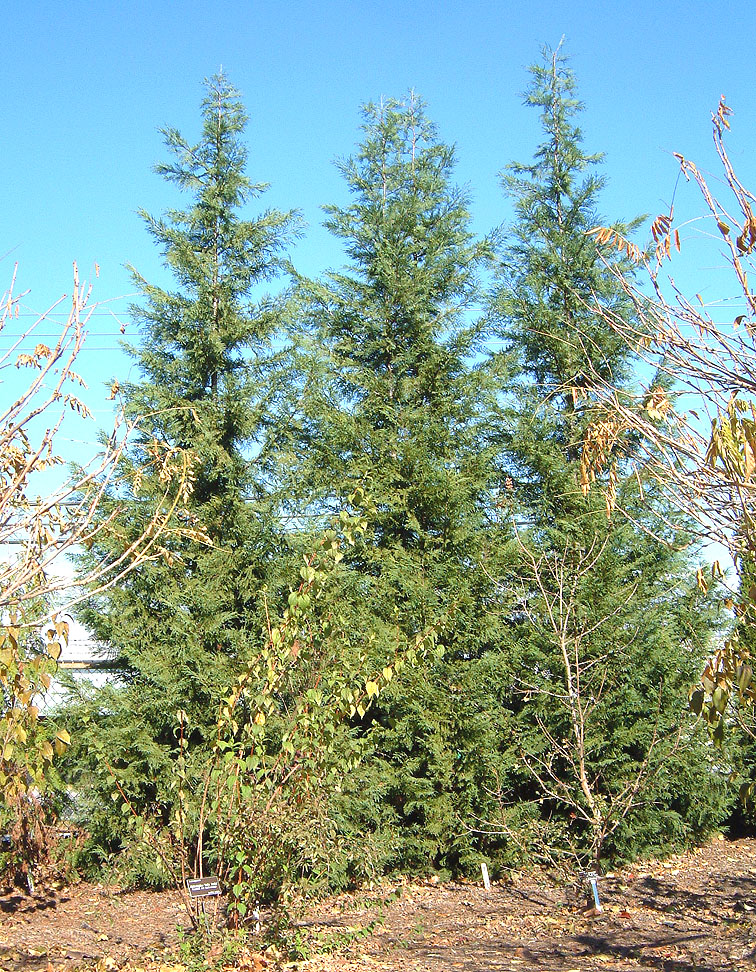 ovensii
- click image
ovensii
- click image
JC Raulston Arboretum. Summer 2002. Why try a hybrid with less density than the
established clones of the Leyland parentage? For one thing this hybrid species
in
the typical clone is much grayer than most of them. Contrast with green hedge
material can be wonderful. There is something different about the open,
horizontal look
of this species that appeals. They do "dense up" in time so a well grown hedge
is still worth one's space. This species does favor the Chamaecyparis
side of the
genetics and that is never all bad.
x Cupressocyparis ovensii
 'Golconda' ('Colconda')
- click image
'Golconda' ('Colconda')
- click image






